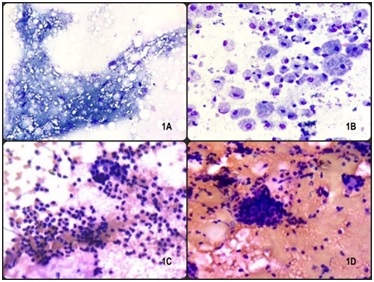Cytopathological study of salivary gland lesions in rural population: Use of the Milan system for reporting
Abstract
Introduction: Salivary gland lesions are superficial lesions & seek attention of patient easily. These lesions vary from non-neoplastic to neoplastic ones and from benign to malignant. Impact of changing habits of people may be reflected in spectrum of oral health & lesions of salivary glands.
Objectives and Method: Present study includes the spectrum of distribution of various lesions of salivary glands in the patients visiting tertiary care rural hospital. In the present study, the Milan system was used for reporting salivary gland cytopathology in 150 cases.
Results: FNAC proved to be a safe and effective modality in diagnosis and planning management of patients with salivary gland lesionsin the rural based population.
Conclusion: Milan system was found characteristically significant for cytopathological diagnosis of SGLs.
Downloads
References
2. Ameli F, Baharoom A, Md Isa N, et al. Diagnostic challenges in fine needle aspiration cytology of salivary gland lesions. Malays J Pathol. 2015 Apr;37(1):11-8.[pubmed]
3. Manvi G, Varun G, Preeti B. Role of preoperative cytology in the management of salivarygland lesions. J Evol Med Dent Sci. 2013:7475- 82.
4. Wong DS, Li GK. The role of fine-needle aspiration cytology in the management of parotid tumors: a critical clinical appraisal. Head Neck. 2000 Aug;22(5):469-73.[pubmed]
5. Mairembam P, Jay A, Beale T, et al. Salivary gland FNA cytology: role as a triage tool and an approach to pitfalls in cytomorphology. Cytopathology. 2016 Apr;27(2):91-6. doi: 10.1111/cyt.12232. Epub 2015 Feb 6.[pubmed]
6. Tyagi R, Dey P. Diagnostic problems of salivary gland tumors. Diagn Cytopathol. 2015 Jun;43(6):495-509. doi: 10.1002/dc.23255. Epub 2015 Jan 22.[pubmed]
7. Jaiswal P, Sharma M, Ahmad F, Khan NS, Sinha SS. Riskbased stratification of salivary gland lesions on cytology: An institutional experience. Iran J Pathol 2018; 13 (2): 220- 28.
8. Viswanathan K, Sung S, Scognamiglio T, Yang GCH. The role of the Milan system for reporting salivary gland cytopathology: A 5 year institutional experience. Cancer cytopatology.Published:March 2018; Wiley Online Library: 1- 11.
9. Savant D, Jin C, Chau K, et al. Risk stratification of salivary gland cytology utilizing the Milan system of classification. Diagn Cytopathol. 2019 Mar;47(3):172-180. doi: 10.1002/dc.24063. Epub 2018 Nov 26.[pubmed]
10. Montezuma D, Canberk S, Aydin O, Dermirhas MP, Vieira AF, Goksel S, et al. Comparision of the reporting system of salivary gland fine needle aspirations:Are they really different? Diagn Cytopathol 2018; 46 (10): 859- 63.[pubmed]
11. Kakoty S, Baruah TD, Babu CPG. FNAC and histopathological correlation of salivary gland lesions : an observational study. Int Surg J 2017; 4: 2148- 52.
12. Dalve KT, Swami SY, Rutuja LU, Narhire V V, Bakshi AP. Study of FNAC of salivary gland lesions in a tertiary care hospital. J Diagnostic Pathol Oncol 2016; 1(2): 24- 28.
13. Shafakat Ahmad, Mohainmad Lateef, Rouf Ahemad. Clinicopathological study of primary salivary-gland tumours in kashmir.JK-practioner 2002; 9 [4]: 231- 33.
14. Jain C. Fine needle aspiration cytology of salivary gland lesions: a study of 70 cases. Int J Med Pharm Sci 2013; 3 (7): 1- 10.
15. Gandhi SH, Purohit TM, Purohit MB, Jethwani D, Vidja M. FNAC diagnosis of salivary gland lesions with histopathological correlation. NJIRM 2013; 4 (3): 70- 77.
16. Singh Nanda KD, Mehta A, Nanda J. Fine-needle aspiration cytology: a reliable tool in the diagnosis of salivary gland lesions. J Oral Pathol Med. 2012 Jan;41(1):106-12. doi: 10.1111/j.1600-0714.2011.01069.x.Epub 2011 Aug 29.[pubmed]
17. Singh A, Haritwal A, Murali BM. Correlation between cytology and histopathology of the salivary gland. Australas Med J 2011; 4 (2): 66- 71.[pubmed]
18. Ashraf A, Shaikh AS, Kamal F, et al. Diagnostic reliability of FNAC for salivary gland swellings: a comparative study. Diagn Cytopathol. 2010 Jul;38(7):499-504. doi: 10.1002/dc.21211.[pubmed]
19. Vaidya S, Sinha A, Narayan S, Adhikari S, Sabira KC. A comparative study of fine-needle aspiration cytology and histopathology in salivary gland lesions. J Pathol Nepal 2011; 1: 108- 13.
20. Joshi AR, Jadhav DS, Baste BD, Ranka SK. A study of fine needle aspiration cytology in salivary gland lesions in a rural population. Int J Adv Med 2017; 4 (2): 307- 10.



 OAI - Open Archives Initiative
OAI - Open Archives Initiative


